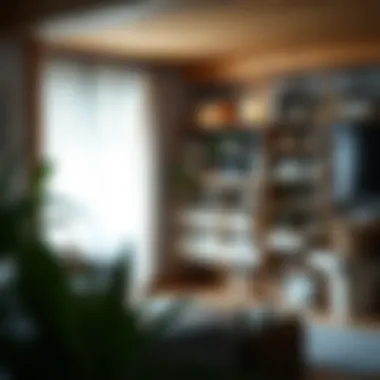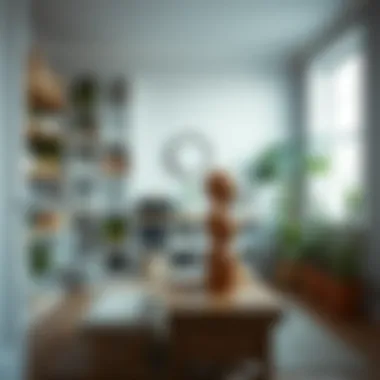Mastering the Art of Decluttering for a Better Home


Intro
Decluttering one’s space goes beyond mere aesthetics; it's about fostering a more harmonious living environment. In today’s fast-paced world, our homes often become repositories for a myriad of belongings, each carrying memories, hopes, and sometimes, unnecessary weight. Recognizing the need for a clean slate can be the first step in a transformative journey. This article aims to provide insightful strategies that not only tackle physical clutter but also address the underlying mindset and emotional attachments we have with our possessions.
Understanding the process of decluttering is paramount. After all, it’s easy to become overwhelmed when faced with a garage brimming with boxes or a closet bulging with clothes. A systematic approach can make all the difference, turning what seemed daunting into achievable milestones. We will delve into specific rooms in the home, share actionable tips, and highlight the psychological as well as practical advantages that come from an orderly environment. Whether you are preparing for a gathering, moving to a new home, or simply wish to breathe new life into your space, this guide will serve as your roadmap toward minimalist bliss.
Why Declutter?
Decluttering isn't just about tidying up; it's a mindful practice that invites clarity and intention into our lives. The benefits are manifold:
- Enhanced Functionality: A well-organized space allows for smoother navigation and increased efficiency in daily tasks.
- Psychological Benefits: Studies show that a cluttered environment can heighten stress levels and distract us from our goals. Reducing clutter can promote a sense of calm and control.
- Aesthetic Appeal: A tidy home is more visually inviting. It reflects a sense of care and thoughtfulness toward one’s living space.
Getting your home in order isn’t just a trend; it aligns with a growing movement towards simplicity and sustainability. With a little effort, a keen strategy, and perhaps some motivational playlists, what once seemed like an uphill battle can evolve into a liberating journey. Now let's explore specific strategies that can facilitate efficient decluttering in your home.
Understanding Decluttering
Decluttering transcends mere organization; it's about fostering an environment that nurtures peace and functionality. This journey invites homeowners, interior design enthusiasts, party hosts, and gardening aficionados to think critically about their possessions and the spaces they inhabit. In a world that often feels chaotic, recognizing the significance of a clutter-free space allows individuals to gain ownership over their lives and surroundings. Thus, understanding decluttering becomes the first step toward rebuilding a serene atmosphere.
The Definition of Decluttering
At its core, decluttering refers to the process of organizing, removing, and managing items in your space. It isn't merely tossing things in the bin or shoving them into a closet, either. Decluttering demands discerning what is essential and what serves no purpose.
For instance, consider that fruit basket nestled on your kitchen counter. If it's more of a dust collector than a fruit holder, it’s time to let go. The act involves weaving through memories and emotions tied to items, separating them from practical utility. Ultimately, the aim is to surrender items that hinder rather than help one’s living experience.
Importance of a Clutter-Free Space
A clutter-free space isn't just visually appealing; it holds transformative potential. It's about cultivating an area where movement flows freely and creativity can blossom. For party hosts, an open and organized living space creates the perfect setting for gatherings, allowing guests to mingle without tripping over misplaced shoes or stacks of magazines.
Moreover, when an interior space breathes, it enhances aesthetic appeal and functionality. Visitors and family members alike can appreciate the curated selections of decor that genuinely reflect the occupant's taste. A clean canvas invites innovation and spontaneity—be it in decor, personal expression, or social engagement.
Psychological Benefits
A cluttered environment often translates to a cluttered mind. Psychology tells us that environment directly influences mood and cognitive processes. When you declutter, you create a sanctuary that promotes relaxation, focus, and decision-making.
Consider the act of organizing a home office; reducing visual distractions leads directly to heightened productivity. Task completion feels less daunting, as the space cultivates a mental replenishment that recharges one’s creativity.
"Clutter isn't just physical; it's emotional and psychological. By letting go, we pave the way for clarity."
Practical Advantages
The practical benefits of a decluttered space are as numerous as they are significant. An organized home simplifies daily routines. For example, knowing exactly where your gardening tools are can save valuable time and effort during planting season.
• Increased Space: A neat area maximizes usable square footage, leading to better quality of life.
• Ease of Maintenance: Less clutter means less to clean. Streamlined living spaces can also help in establishing more consistent cleaning habits.
• Financial Savings: Often, decluttering leads to the realization of excess. With unnecessary items sold or donated, one can benefit financially while contributing positively to community welfare.
In summary, understanding decluttering is not just about sorting through possessions; it's a foundational step to reshaping one's living experience. It brings clarity both emotionally and spatially, allowing individuals the chance to cultivate their ideal atmosphere.
Key Areas to Declutter
Finding the right path to a clutter-free living space starts by pinpointing the key areas that commonly gather the most clutter. Recognizing these places is vital as they serve as breeding grounds for disorganization. It’s not just about getting rid of what you don’t need; it’s about understanding where clutter tends to accumulate and why addressing these spots can greatly enhance your living environment.
A well thought-out decluttering strategy can foster a sense of peace and improve overall productivity. Each area of the home serves a purpose, and when that purpose gets hindered by unnecessary clutter, it can weigh heavily on your mind. Not only does it help streamline functions within the home, but it also creates a more inviting atmosphere for family and guests alike.
Living Room
Identifying Unused Items
In the living room, identifying unused items is often the first step towards reclaiming that cherished space. It’s all too easy for the living room to become a dumping ground for various items that seem to find their way in, but rarely get used. Items like old magazines, decor that has gone out of style, or kids' toys that have seen better days can quickly accumulate.
Taking the time to analyze what’s truly serving a purpose can lead to better allocation of space. This practice is beneficial as it encourages you to reassess your belongings. A major characteristic of identifying these items is being somewhat brutal in your assessment; often, it’s not easy to let go. However, once you start, the sense of relief can be quite liberating. The key advantage here is that freeing up space allows for a more functional and aesthetically pleasing living area.
Strategies for Storage
Strategies for storage in the living room should prioritize maximizing space while keeping it functional. Utilizing multi-purpose furniture, like an ottoman that doubles as a storage bin, optimizes the little space you might have. By choosing pieces that serve dual roles, you both declutter and enhance room functionality.
One unique feature of effective storage solutions is that they cleverly hide away clutter while still letting you maintain easy access to necessary items. It helps keep the environment organized without compromising style. However, a disadvantage could be that some furniture storage options might be more expensive upfront. Nonetheless, viewing them as investments can make them valuable in the long run.
Creating a Relaxing Atmosphere
Creating a relaxing atmosphere in the living room can take some deliberate effort, but it’s worthwhile. It’s where many of us unwind after a long day, so ensuring that the space is welcoming is paramount. By decluttering, introducing soothing colors, and adding soft textures, you can turn your living room into a haven.
The pivotal characteristic here is arranging furniture and decor with relaxation in mind. This might mean moving away from cluttered walls, or simply ensuring that your lounge area is free of distractions. One major advantage of a well-planned relaxing atmosphere is its impact on mental well-being—diminishing stress can happen simply by changing one’s environment.
Kitchen


Assessing Kitchen Gadgets
In the kitchen, assessing kitchen gadgets plays a crucial role. We’ve all been guilty of hoarding gadgets that we convinced ourselves would simplify cooking or food prep, only to find them gathering dust. Cutlery that has never seen the light of day can take up valuable space on counter or drawer area.
An essential tactic here is to ask yourself if you’ve used the gadget in the last year. Focusing on this question helps clarify what’s truly needed versus what’s just taking up space. The advantage of this approach is it tends to lead to a more efficient and practical cooking environment.
Organizing Pantry Essentials
Organizing pantry essentials is another paramount aspect in a kitchen decluttering strategy. A disorganized pantry can become the labyrinth of chaos where finding a simple ingredient turns into a treasure hunt. By clearing items that don’t belong and organizing the essentials, a clearer view of what you have available comes into play.
The unique feature of an organized pantry is not only visual clarity but also the potential to save money by preventing over-purchasing of similar items. One downside might be the time investment required initially, but once organized, it mostly maintains itself with some upkeep.
Streamlining Counter Space
Streamlining counter space is about decluttering not only physical items but also making sure your counter serves its purpose effectively. A cluttered counter makes cooking harder and can take away the joy of meal prep. One strategy is to limit what remains on the counter to only the most essential items, such as a coffee maker or cutting board.
This transformation allows the kitchen to become more functional. The distinct advantage of streamlined counter space is not only ease of use, it also fosters a cleaner, more appealing workspace. However, it’s minimalistic approach may displease those who prefer the cozy feel of a full kitchen.
Bedroom
Decluttering Wardrobe Chaos
Ground zero for bedroom clutter often lies within the wardrobe. Decluttering wardrobe chaos is an essential positive step that propels the entire room toward tidiness. Sorting through clothing, shoes, and accessories fosters clearer insight into what is truly worn and needed versus excess that goes untouched.
An advantage here is that you might rediscover pieces you love and had forgotten, cutting down on the urge to constantly shop for new outfits. It does require honesty with yourself, though, about what truly fits your lifestyle today.
Minimizing Nightstand Clutter
Minimizing nightstand clutter is equally important. This small space can easily become a catch-all for miscellaneous items, from books to chargers. A clean nightstand creates a calm setting for restful sleep. The key characteristic here involves determining what belongs versus what distracts.
The unique benefit is it fosters an environment that promotes relaxation—an area devoted to tranquility instead of chaos. A downside could be that some sentimental items get removed in the process, but a balance must be reached to preserve a peaceful ambiance.
Creating Functional Storage Solutions
Creating functional storage solutions in the bedroom could reroute how you view spaces within the room. Under-bed storage or incorporating baskets can drastically open floor areas and provide much-needed organization. This choice proves beneficial, as it redirects items elegantly while maintaining ease of use.
One tricky aspect is this has a potential to lead to more clutter if not regularly checked; but ideally, this system offers manageable solutions tailored to your daily routine.
Home Office
Evaluating Office Supplies
In the home office, evaluating office supplies cannot be overlooked. Often, we hoard pens, papers, and gadgets that pile up unnecessarily. By combing through items, you can prioritize essentials, streamlining your workspace for better focus and creativity.
The main benefit of this exercise includes realizing just how much space you truly have available once the clutter is cleared. However, the challenge comes when deciding on what to keep or toss, which can be more subjective and personal.
Managing Digital Clutter
Managing digital clutter is equally critical in this day and age where our work often spills into the digital realm. Emails, documents, and files can drown you if not tamed. An organized digital space improves productivity, making it easier to find what you need when you need it.
The advantage is that this will free up storage on your devices, which can improve performance. One downside is some may find tech-related clutter harder to navigate than physical items.
Enhancing Productivity Through Organization
Enhancing productivity through organization involves creating systems that foster efficiency. Whether it’s designating specific places for files or organizing a calendar, every move should guide you toward what needs to be done in a timely manner.
The main feature of good organization here is clarity. An advantage is that it provides your workspace with flow, creating a conducive environment for focus. Some might find it challenging to set up lasting systems, but investing time upfront pays off.
Bathroom
Taming Toiletries
Taming toiletries in the bathroom is an often-overlooked necessity. Let’s face it; it’s all too easy to accumulate a collection of products that might just gather dust. By evaluating what you actually use, you simplify your routines and enhance your daily rituals.
The key advantage is reducing decision fatigue caused by clutter. On the contrary, it might be difficult to let go of items tied to personal care routines or beauty regimens.
Implementing Smart Storage Ideas
Implementing smart storage ideas is essential for maintaining an organized bathroom. Think vertical shelving or under-sink cabinets that host all those products without crowding your space. This creative approach utilizes often-hidden areas, making the most of available space.
An upside excels in keeping frequently-used items at hand, while a downside could be the need for initial financial investment in storage solutions.
Maintaining a Spa-like Retreat
Maintaining a spa-like retreat can turn your bathroom from a mere functional space into an oasis of relaxation. Creating an environment of tranquillity enhances your bathing experience, making it feel more like a mini-vacation at home.
A key feature here is decluttering to allow for calming elements like candles or soothing colors. The disadvantage could lie in the commitment of time to create this ambiance, but the payoff could be, quite literally, refreshing.


Garage and Storage Spaces
Sorting Seasonal Items
Sorting seasonal items in the garage is vital. Each season brings different needs, from holiday decorations to garden supplies for springtime. By sorting these items, you prevent clutter from festering and transferring from one season to the next.
An advantage is that this creates space for current seasonal items, allowing for efficient use of the area throughout the year. One downside might include the potential stress of sorting through items but in a long-term perspective, it alleviates future discomfort.
Utilizing Vertical Space
Utilizing vertical space can be a game changer in garages and storage areas. Shelving units and wall-mounted storage options allow for a maximal organization while conserving floor space. This method opens up the area for easier navigation and access.
An advantage is transforming a cramped space into a more functional one, yet it can require upfront investment in tools or shelving units. The payoff typically serves its purpose well over time.
Regular Maintenance Practices
Regular maintenance practices ultimately bring a breath of fresh air to cluttered spaces. Having routines or schedules in place can create accountability and help keep clutter at bay. Establishing strategies for checking in regularly can cultivate a more proactive environment.
The fundamental benefit is the prevention of buildup over time, creating a much less demanding process than sporadic cleanings. However, integrating these practices requires discipline, which some may find challenging.
Taking these steps to address each key area can pave the way for a harmonious living space, rich with functionality and ease. In the end, decluttering is not solely about removing excess, but fostering an environment that elevates everyday life.
Effective Decluttering Techniques
When the clutter creeps into your space, it’s all too easy to feel overwhelmed. Effective decluttering techniques play a crucial role in addressing this issue. These approaches not only streamline the process but also bring clarity to your environment. It's not just about tidying up; it's about creating a lifestyle that supports tranquility and functionality. In this section, we will explore three key techniques that can transform your cluttered space into an oasis of order.
The Four-Box Method
One of the simplest yet most powerful techniques is the Four-Box Method. This approach involves four designated boxes or areas, labeled as follows:
- Keep: Items that you use regularly and that add value to your life.
- Donate: Things that you no longer have use for but can benefit others.
- Trash: Items that are broken or completely worthless.
- Undecided: Goods you’re unsure about, which need further contemplation.
By categorizing your belongings, you can make quick decisions about what to do with each item. This method encourages you to think critically about what you really want to keep. When you open that box labeled "undecided," be honest with yourself. Chances are, if you haven’t missed it in the past year, it's probably time to let go.
The Marie Kondo Approach
Marie Kondo's philosophy captivates many with her minimalist view on decluttering. The KonMari Method is rooted in the idea that you should keep only those things that "spark joy." It’s a refreshing perspective that steers the decluttering process away from obligation and towards genuine appreciation.
- Commit yourself to decluttering: Approach it as a journey, not a chore.
- Visualize your ideal lifestyle: Picture what you want your home to feel like. This vision can guide your choices.
- Tackle categories, not rooms: Instead of focusing on one area, consider going through categories such as clothes, books, or sentimental items.
- Thank items before you part with them: Acknowledge their role in your life and create a closure before letting go.
Kondo's method is particularly effective in helping individuals manage emotional attachments, fostering a deep connection with the concept of simplifying life. It's not just about discarding; it's about enhancing the overall ambiance of your home.
Digital Decluttering
In today’s tech-driven age, decluttering isn’t just about physical possessions. Digital decluttering is equally vital. Our devices house a trove of files, emails, and photos that can quickly accumulate.
To begin:
- Organize files into folders: Create a straightforward structure that allows easy access.
- Unsubscribe from unnecessary emails: Clear out mailing lists that clutter your inbox.
- Delete apps that you no longer use: They take up space and distract you.
- Back up important files: Using a cloud service can help ensure you keep what matters while regularly pruning the rest.
Digital decluttering brings a sense of control over not just your physical space, but your virtual landscape as well. It helps in maintaining focus and enhancing productivity by reducing distractions.
Incorporating effective decluttering techniques can lead to a more organized, refreshed, and mindful living environment. These methods are not just about cleaning; they represent a lifestyle change towards simplicity and purpose.
In summary, understanding and applying effective decluttering techniques can make a world of difference in your lifestyle. Whether it’s utilizing the Four-Box Method for a systematic approach, embracing the joy-focused philosophy from Marie Kondo, or tackling the digital chaos, a cleaner space is only a few steps away.
Challenges and Solutions
In the journey of decluttering, individuals often encounter roadblocks that can hinder the progress. Recognizing these challenges is as crucial as understanding the benefits of a clutter-free space. Addressing these obstacles not only enhances one's commitment to declutter but also reaps emotional and practical rewards. By exploring various common challenges, we can provide actionable solutions that ensure a smoother, more fulfilling decluttering experience.
Emotional Attachment to Items
One of the biggest hurdles in decluttering is the emotional connection people develop with their belongings. Items acquired over years or gifted by loved ones often hold sentimental value. For instance, a grandmother's china set, despite being stored away, can evoke memories of family gatherings and traditions. This attachment can create a mental tug-of-war, making it difficult to part with cherished items.
To navigate this emotional landscape, consider the following strategies:
- Acknowledge Your Feelings: Recognize that it's normal to feel attached to certain items. Allow yourself to process these emotions before making decisions.
- Create a Memory Box: If certain items hold significant memories but occupy too much space, designate a memory box where you can place a few smaller, meaningful pieces.
- Cut Down on Duplicates: Often, we hold onto similar items that serve the same purpose. Evaluate these duplicates and select only the ones that truly resonate with you.
Ultimately, it's about channeling your memories into a manageable collection without keeping everything.
Time Management Issues
Another common issue is finding time to declutter amidst a busy lifestyle. Juggling work, family, and social commitments can leave little room for organizing. This can lead to feelings of frustration when your space does not reflect your desired order.
Here are some practical tips for better time management:
- Set a Timer: Dedicate a specific amount of time, even if it’s just 15 minutes a day, to declutter one section. You'd be surprised at how much can get done in short bursts.
- Schedule Decluttering Blocks: Treat it like an important appointment and block out time on your calendar. Stick to your commitment just like you would for any other task.
- Break it Down: Instead of tackling the whole house at once, focus on one area or category at a time, which can make the task feel less daunting.


By approaching decluttering in a time-efficient manner, you'll find it becomes part of your routine rather than an overwhelming chore.
Overwhelm and Burnout
Feeling overwhelmed by the sheer volume of items can often lead to burnout. When one looks at a room overflowing with belongings, the thought of sorting through everything can seem Herculean. This sense of overwhelm can diminish motivation and lead to procrastination.
To overcome these feelings:
- Establish Clear Goals: Set specific, attainable goals for each decluttering session. For example, aim to clear out one cabinet or a single drawer instead of the entire room.
- Practice the "One In, One Out" Rule: For every new item you bring into your home, consider letting go of an existing item. This keeps clutter at bay and helps maintain a balance.
- Celebrate Small Wins: Recognizing progress, no matter how minor, can bolster motivation. Take a moment after each session to appreciate your efforts.
By navigating overwhelm through clear planning and small achievements, the decluttering process becomes more manageable and less of an emotional burden.
"Successfully managing clutter isn't a single battle; it's an ongoing lifestyle choice that helps maintain peace and clarity in daily living."
By understanding and addressing these common challenges, decluttering can transform from a daunting task into a liberating process. Engaging with your space thoughtfully fosters growth and can ultimately lead to a more organized, peaceful home environment. For more insights, consider visiting Psychology Today or The Minimalists for their unique perspectives on decluttering and mindfulness.
Maintaining a Clutter-Free Environment
Creating and maintaining a clutter-free environment is not merely a one-time event; it's a continuous journey. In the hustle and bustle of daily life, it’s easy for items to accumulate, creating an overwhelming space that can stifle creativity and peace of mind. The process of maintaining a clutter-free home is essential as it fosters not only physical clarity but also mental relief. A tidy space can enhance productivity, improve mood, and create an inviting atmosphere not just for you, but for guests too.
The habit of keeping your environment organized extends beyond daily tidiness. It involves adopting a mindset that prioritizes functionality and aesthetic appeal. Whether you're a seasoned declutterer or just beginning, there are simple strategies that can make this process easier and sustainable. By establishing routines, embracing minimalism, and conducting regular check-ins, you can create a cycle of cleanliness that becomes second nature.
Establishing Daily Routines
Daily routines can be a straightforward solution to avoid clutter from accumulating again. The idea is to spend a few minutes each day on small tasks that contribute to a more organized space. Think of these routines as quick wins – little tasks that, when added up, can lead to significant change. Here are a few strategies to consider:
- Five-Minute Rule: Dedicate five minutes to tackle clutter whenever you have a spare moment. Put items back in their place or dispose of mail and newspapers.
- Nightly Clean-Up: Each evening, take a few moments to tidy up before bed. This sets a clean stage for the next day and helps cultivate a sense of order.
- One In, One Out: When you bring in something new, let go of something old. This principle helps manage the volume of items you own, preventing the slow creep of clutter.
Establishing these habits requires consistency and mindfulness. It's key to recognize that the more you incorporate these routines into your life, the more effortless they will become.
Incorporating Minimalism
Minimalism isn't just a trend—it's a lifestyle choice that emphasizes simplicity and intentionality. Incorporating minimalism into your life can fundamentally alter how you view possessions. It encourages you to focus on what truly matters by eliminating excess. Here are some points to ponder about minimalist living:
- Quality Over Quantity: Invest in quality items that serve a purpose or bring joy. A few high-quality pieces can have more value than a multitude of lesser ones.
- Mindful Purchasing: Before buying something new, ask yourself if it adds tangible value to your life. Will it enhance your daily routine or simply add to the clutter?
- Evaluate Regularly: Once you begin living more minimally, revisit your environment periodically. Assess whether your belongings still align with your current lifestyle.
When adopted thoughtfully, minimalism can lead to significant emotional benefits, from reduced anxiety around clutter to a more grounded existence.
Regular Check-ins
Setting aside time for regular check-ins can significantly bolster your clutter-free goals. This involves deliberately scheduling moments to assess and reevaluate your space.
- Monthly Reviews: At least once a month, review your spaces. Check for items that have crept back in or areas that may need a bit of TLC.
- Seasonal Decluttering: As seasons change, so do lifestyle needs. Take time to reassess your wardrobe, gadgets, or home decor. This can keep your space aligned with your evolving tastes and requirements.
- Accountability: Enlist a friend or family member to help you stay accountable to your decluttering goals. Sometimes, just talking about your progress can reinvigorate your efforts.
"A clutter-free space is not just a tidy area—it represents peace in your inner world."
Maintaining a clutter-free environment is a practice of intentional living. By establishing daily routines, embracing a minimalist mindset, and conducting regular check-ins, you can cultivate a space that nurtures creativity and harmony.
Decluttering as a Sustainable Practice
Decluttering is not merely about tidying up a space; it reflects a deeper commitment toward sustainability and mindful living. When we speak of decluttering as a sustainable practice, we're delving into ways that this endeavor can extend beyond personal benefit to positively affect our environment and community. A home free from excess clutter allows for better organization, improved mental clarity, and, when done thoughtfully, contributes significantly to sustainable living.
Recycling and Upcycling
Recycling and upcycling are essential components of a sustainable decluttering strategy. When you sift through your belongings and encounter items that no longer serve you, consider first how these objects can be reused or repurposed. Not all items need to end up in a landfill. For instance, an old glass jar can be transformed into a charming planter for herbs, or worn-out clothes can be reimagined into chic cleaning rags. Taking these steps significantly reduces waste.
- Common items to recycle:
- Paper products: Magazines, newspapers, and cardboard boxes can be transformed into new materials.
- Electronics: Many counties have designated drop-off points for e-waste, ensuring that these devices are disposed of appropriately.
Engaging in recycling not only helps clear your space but also contributes to a cleaner environment. Upcycling can turn the mundane into the extraordinary, giving new life to what once seemed useless.
Charitable Donations
Another pragmatic approach in the realm of sustainable decluttering is to donate. Many organizations welcome gently used items, whether clothing, furniture, or household goods. Donating not only benefits those in need but also fosters a sense of community.
- Here’s what to keep in mind when donating:
- Quality matters: Ensure items are in good shape, making sure someone else can benefit from them.
- Choose the right charity: Research local shelters or charities that align with your values.
- Follow donation guidelines: Many places have specific requirements about what they will accept.
By distributing unwanted items through charitable donations, you alleviate yourself of clutter, while also supporting those who may not have the means to purchase items anew.
Selling Unwanted Items
Selling unwanted items is another practical avenue in promoting sustainability. Whether through online platforms like eBay, local Facebook groups, or yard sales, selling can address two issues at once — clearing clutter while earning a few bucks.
- Consider these tips for a successful sale:
- Take quality photos: Showcase your items in the best light to attract buyers.
- Set fair prices: Do your research to price items competitively.
- Be honest: Disclose any flaws to maintain trust with potential buyers.
Each dollar earned can be reinvested into your home or saved for future endeavors, illustrating that decluttering can carry both immediate and long-term benefits.
"The goal is to declutter sustainably, closing the loop on consumerism by recycling, donating, or selling—turning what once was surplus back into value."
For more detailed insights, refer to resources such as EPA, Wikipedia on recycling, or community forums like Reddit.



